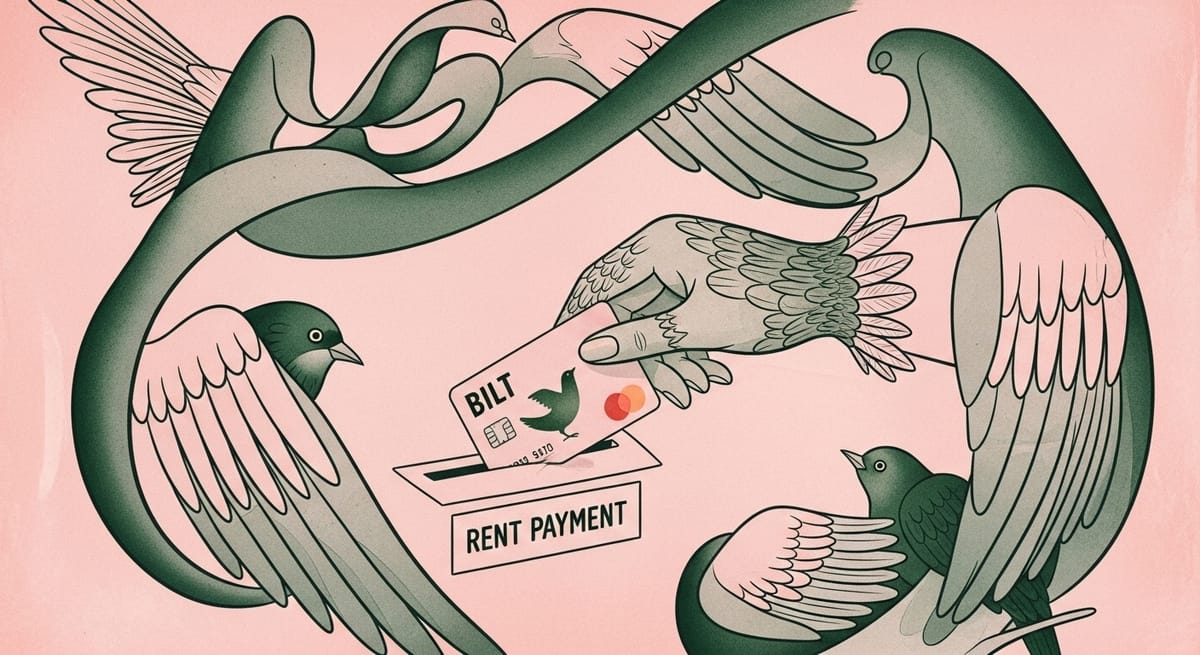Bilt Rewards in Q4-2025: How Renting Became a Loyalty Asset
Bilt started as a novel rent reward tool. By Q4-2025, it’s matured into a loyalty infrastructure: embedded in property ecosystems, battling for redemption real estate, and hinting at alliances beyond travel - maybe even with Rakuten.


If You Only Had 60 Seconds to Read This Article
| Click Here 🤏🏻
Bilt has outgrown its “rent rewards” origin. By late 2025 it functions as a full-scale loyalty infrastructure linking property groups, banks, and travel partners into one economic loop. The program now processes billions in rent payments and touches millions of apartments through integrated landlord APIs, while tightening its earning rules to control cost: 1 point per $2 in rent, capped and gated behind minimum spend activity.
Its competitive edge lies in transfer partnerships - Hyatt, American, Alaska, United, and the Avios network - plus its monthly Rent Day ritual that drops 50-75% bonuses and drives user behavior like a financial market. The rumored addition of Rakuten as an earn partner hints at a coming fusion between rent, shopping, and everyday spend, turning Bilt from a niche fintech into a mainstream loyalty exchange.
Behind the pageantry, Bilt’s economics are tightening: thin interchange margins, large liability floats, and the need for continual engagement to keep users transacting. A three-tier card lineup and deeper landlord integrations show how it plans to scale without eroding yield. The winners are users who treat points as capital - liquid, rotated, and timed to market—not as souvenirs of good intentions.
The broader takeaway: Bilt didn’t just make rent rewardable; it made housing transactional. In 2025, loyalty isn’t about luxury or status—it’s about embedding yield into obligations. Rent has become a balance-sheet asset, and Bilt sits at the center of that conversion.
Everything else you need to know is just below 👇🏻
🎞️: Powered by NotebookLM @ UpNonStop
Prologue: The New Loyalty Frontier
By the close of 2025, Bilt is no longer a fringe experiment. It handles billions in rent flows, touches millions of apartments, and commands attention from banks, property owners, airlines, and retailers. The real question now is not ifrent can generate value but how much and for whom.
In 2025, loyalty is no longer about isolated cards or points. It’s about capture: capturing your most nondiscretionary habit (housing), and converting it into optionality.
Bilt, in that sense, is a new kind of platform - less “card program,” more “resident economy.” And inside that economy, three dimensions now matter more than ever: earning structure, redemption optionality, and partner orchestration.
Part 1: Scale, Reach, and Infrastructure in 2025
By Q4, Bilt’s footprint is vast. It partners with major property operators nationwide, and its network claims to cover millions of units - multi-family, co-living, and mixed-use complexes. Rent processed via Bilt now comprises a non-trivial share of first-of-month flows in many metro markets.
Its infrastructure has matured: more robust payment rails (ACH and advanced validations), fraud controls, landlord APIs, and resident portals are stable and battle-tested. The operational overhead grows, but so does the moat.
Because Bilt touches rent directly - a payment that happens month in, month out - its distribution is harder to replicate than a credit card salesforce. No bank has that embedded reach into residential ecosystems. That’s Bilt’s edge.
Part 2: Earning Redefined: 2025’s Structural Moves
A. The Base Rate Reset
In 2025, Bilt adjusted its baseline earn rules. The “1 point per $2 of rent via Bilt’s platform” is now the standard floor - but with conditions.
Those include:
- A minimum card spend or engagement requirement in the same billing cycle.
- A monthly cap on the portion of rent eligible for full point accrual: beyond that, marginal rent gets no reward or lower reward.
- For properties not fully integrated in Bilt’s ecosystem, a fallback (lower) rate or no reward option.
These controls reduce downside risk and cost drag.
B. Bonus Categories & Tier Incentives
To encourage usage beyond rent, Bilt layered more bonus categories in 2025: neighborhood dining, travel-related merchants, groceries in select zip codes. High-tier card variations (under development) promise bonus multipliers. The aim: turn Bilt into a daily-spend companion, not just rent’s sidekick.
C. Marketing & Engagement Changes
In 2025, Bilt’s customer acquisition subsidies tightened. Rather than blanket 2× bonus promotions, Bilt now gates high multipliers behind tenure, rent volume, or user habits. New users get entry-level rates; power users unlock “multiplier status” over months. This reduces margin erosion from aggressive subsidies.
Part 3: Transfer Market 2025 | Where Value Lives (and Whispers...)
By late 2025, nearly all value in Bilt still flows through transfer partners. The internal rent-credit redemptions, Amazon credits, or student-loan payoff options are convenience paths, not yield drivers.
A. Transfer Corridor Strategy
Bilt’s partner roster in 2025 is deliberate, lean, and curated. The airlines and hotel chains it supports are those with premium cabin juice or global reach - Hyatt, American Airlines, Alaska, United, Flying Blue, Avios networks. That keeps Bilt from becoming a “points store” and anchors it in aspirational travel.
Its transfer ratios and bonus politics are tighter than older programs. Occasional transfer bonuses (e.g. 25%, 50%) still exist, but Bilt spaces them out more selectively, making each fly-up feel like a real market event.
Importantly, Bilt also reserves flexibility: it can adjust transfer ratios for future partners. There’s stealth speculation in travel communities that Rakuten may soon be added - not as a transfer destination, but as an earn partner, allowing you to accrue Bilt points through Rakuten shopping. That would turn Bilt into not just a rent rewards engine, but a hybrid shopping–loyalty fabric. If true, it repositions Bilt adjacent to shopping portals, creating new levers in everyday spend.
B. Timing & Transfer Discipline
Because transfer seats and partner inventory vary, Bilt has increasingly emphasized only transferring when you can execute. It’s teaching users not to send points into the void. When a partner route is live and bookable, transfer. Otherwise, wait. This discipline limits stranded balances and reduces regret.
C. Sweet Spots & Structural Advantages
In 2025, the strongest redemptions remain those with asymmetric value -transatlantic business deals, off-peak European flights, and exotic partner-based first class via niche carriers. Bilt’s design is to preserve these in its ecosystem. The fewer “sub-par” partners it carries, the more each corridor retains scarcity value. That’s deliberate: Bilt doesn’t want to be “everywhere.” It wants to be exceptional where it shows up.
Part 4: Mechanics & Currency Dynamics
A. Velocity vs. Hoarding
If there is a currency law in Bilt’s world, it’s this: don’t hoard. Points unspent are fragile. That’s why Bilt leans hard into Rent Day mechanics (see next section), bonus windows, and time-limited offers. The model demands velocity.
B. Breakage and Liability Control
Unlike older loyalty programs that depend heavily on breakage (unredeemed points), Bilt’s liability is more visible. It must constantly calibrate how many points it allows to remain unredeemed, how many bonus events it can run, and how much liability float it holds without risking overhang. The 2025 tweaks to earning and caps reflect that calibration.
C. Flooring & Redemption Multipliers
Initially, Bilt flirted with rent credits as a soft floor - letting users redeem points back into rent. But in 2025, that pathway has been limited. It’s useful as a safety valve, but the true floor is always “what transfer value you can get.” Bilt ensures that transfer value remains at least slightly above rent-credit equivalency in baseline months, with bonus peaks pushing it much higher.
Part 5: Rent Day & Behavioral Architecture
In 2025, Rent Day is not optional. It is the calendar anchor of Bilt’s behavioral infrastructure.
A. Monthly Cadence & Rituals
On the 1st of every month, Bilt triggers offers: transfer bonuses, redemption rates, special partner activations (restaurants, fitness, events). These aren’t gimmicks - they are demand-shaping tools. Users either act or lose. The psychology is reinforced: paying rent becomes a deliberate decision with upside.
B. Promotional Aggression & Surprises
Q4 promotions are high stakes. In October 2025, Bilt offered a 75% bonus on rent-point redemptions, 50% Amazon redemption boosts, sweepstakes, and surprise tie-ins (concert tickets, local experiences). Future months are rumored to stretch bonuses for new user cohorts or city-specific leads. Rare is the month without at least one “Rent Day surprise.”
C. Reinforcing Ritual Over Habit
What keeps users engaged is not just the money - it’s the ritual. Linking the first-of-month, the renewal of obligations, and the payoff of value makes Bilt part of the mental calendar. Users anticipate the drop. They plan. They hold points knowing the window is coming. That’s loyalty by bending temporality, not just points.
Part 6: Monetization, Margin, & Pivots
A. Margin Squeeze & Realignment
By 2025, some of Bilt’s prior generosity is being dialed back. Reference rates, caps, and gating mechanics show that cost pressure is real. The margins in rent-to-points arbitrage are narrow. Bilt must balance incentives with defensibility.
B. Card Product Strategy
The move toward a three-tier card lineup is imminent. The existing Wells Fargo co-brand is likely the mid-tier. A no-fee baseline card and a premium annual-fee version (with enhanced earning or perks) are in development. That segmentation is critical: users with heavy rent and spend should upgrade to richer yields, while lightweight users stick at entry. The card suite becomes a yield ladder inside Bilt’s world.
C. Platform & Real-Estate Leverage
Bilt’s embeddedness in residential infrastructure gives it leverage over property operators. New features (smart-home tie-ins, resident offers, renewal incentives, move-in bonuses) can be monetized or white-labeled into property tech stacks. Those revenue paths are under active development in 2025.
D. Data & Financial Upsells
What Bilt really owns is housing data - lease history, move-out patterns, rent trends, payment reliability, and resident lifestyles. Over time, that becomes a financial asset: mortgage referrals, proptech insight, rent-market forecasting, or embedded financial products (insurance, deposits, credit). But monetizing that means walking a regulatory tightrope - residents trust Bilt because their rent is sacred.
Part 7: Risk Horizons in Late 2025
A. Oversubscription & Redemption Pressure
If Bilt leans too hard into large transfer bonuses, it could drain its liability reserves. The temptation to push aggressive offers is constant: but each must be tethered to earning discipline.
B. Issuer/Bank Risk
The relationship with Wells Fargo is foundational. But future card expansion could bring in new partners with conflicting incentives or demands. If issuer margins tighten, or regulatory costs rise, Bilt’s model could strain.
C. Partner Devaluation & Contract Renewal
If airlines or hotel partners shift pricing, exit partnerships, or demand renegotiation, Bilt’s redemption value slides. Especially because Bilt supports fewer partners, each change carries greater impact.
D. Behavioral Attrition
If Rent Day loses luster (if bonus windows become predictable or the uplift shrinks) users may treat Bilt as secondary. Sustaining surprise, narrative, and evolving features is vital.
E. Liability & Accounting Exposure
Holding billions in point liability, especially in peak months, is a financial risk. If redemptions spike unexpectedly, Bilt must have funding reserves and buffer mechanisms. The 2025 structural changes (caps, gating) suggest Bilt is already building defenses.
Part 8: Strategy Prescription (How to Use Bilt Today)
- Treat Bilt as a tactical accumulation account. Don’t funnel all your loyalty flow there yet. Use Bilt when its transfer yields beat your fallback models.
- Plan your transfers. Only move points when award space is held. Don’t gamble on future bonus windows unless you accept stranded risk.
- Save enough for bonus windows. Keep margin in your balance so that when a 50–75% bonus drops, you can act.
- Watch the card lineup closely. When the no-fee or premium cards appear, evaluate upgrade paths that maximize yield on your rent + spend profile.
- Pair Bilt with Chase/Amex. Use Bilt for its unique corridors and rent leverage; use Chase/Amex for breadth and flexibility.
- Test rent redemptions sparingly. Redemptions back into rent or Amazon are useful backup paths but usually under-yield. Use them when transfer routes are weak.
- Monitor rumors like Rakuten. If Bilt adds everyday shopping earn via Rakuten or similar, its addressable spend base would widen dramatically. Be ready to lean into that curve.
Case Study: The Operator Couple | From Rent Payment to Round-the-World
Profile
Two professionals in their 30s, living in a Manhattan high-rise under an AvalonBay lease integrated with Bilt. Combined rent: $5,300/month.
Problem
Before Bilt, rent was a dead weight. They paid via ACH, earned nothing, and hoarded Chase points from travel and dining. By late 2024, they realized their rent (more than $60,000 a year) was their largest unleveraged payment.
Play
They switched to Bilt in early 2025 and segmented their usage. Rent earned 1 point per $2 (≈30,000 Bilt points per year). Dining spend added another 18,000. They focused on Rent Day bonuses, using October’s 75% uplift to transfer 60,000 Bilt points into American Airlines miles.
Then they built a hybrid redemption: outbound JFK-MAD on Iberia business (off-peak, 34,000 Avios after bonus), return via AA Premium Economy (36,000). Out-of-pocket taxes totaled $180.
Outcome
Effective yield: 2.1¢ per point - a 120% lift over the rent-credit baseline. What used to be 12 rent payments became a pair of transatlantic tickets.
Lesson
They didn’t hoard. They calendared each Rent Day, waited for the right transfer window, and treated rent as a yield vehicle. Their loyalty ROI came not from chasing “free,” but from timed liquidity - a discipline Bilt now rewards explicitly.
Case Study: The Small-Business Landlord | Earning Where Tenants Pay
Profile
A 42-year-old small landlord in Austin managing 12 rental units. He uses Bilt to collect rent through its ACH portal and pays his own personal rent (in another city) via Bilt’s Mastercard.
Problem
He wanted to modernize rent collection, but most platforms charged processing fees with no offsetting value. Bilt offered fee-free ACH plus loyalty upside on his own housing spend.
Play
By onboarding his tenants into the Bilt ecosystem, he gained visibility and improved payment consistency. Tenants paid on time to earn their own Bilt points; delinquencies dropped 40% quarter-over-quarter.
Meanwhile, his own rent payments and card spend generated ~25,000 Bilt points in 2025. During September’s Rent Day, he transferred 20,000 points into Hyatt for a 3-night redemption at a category-5 property - otherwise $900 cash value.
Outcome
He turned a property-management necessity into an engagement loop: tenants earned for paying rent, he earned for collecting rent, and Bilt gained stickiness across both sides of the housing equation.
Lesson
The loyalty model now cuts both ways. Bilt’s real genius is not rewarding a single user - it’s rewarding the transaction network. In 2025, value lives not in one side of the payment, but in the shared behavior it sustains.
Part 9: The 2025 Verdict: Rent, Loyalty, & the Power of Embeddedness
Bilt isn’t a novelty anymore; it’s a redefinition. It was never enough to let renters earn points. Bilt’s real innovation is making the act of renting a vector for capital - one that behaves like venture funding, not consumer subsidy.
Loyalty’s next frontier isn’t in fancy cards or bonus categories. It’s in obligation capture. Bilt sits at the intersection of affordability, finance, property, and travel. Its leverage comes from owning the payment behavior that underwrites every other loyalty decision.
The rumored shift toward Rakuten earning partnership would be a signal of Bilt’s next act - blurring the lines between rent, shopping, and daily life. If that narrative comes true, Bilt might become not only the rent rewards program, but the resident portal for life.
But for now, the power lies in liquidity, velocity, and discipline: the renter who acts like an operator will outpace the hoarder. The real product in 2025 isn’t points. It’s choice - and for once, renters have it.




